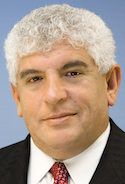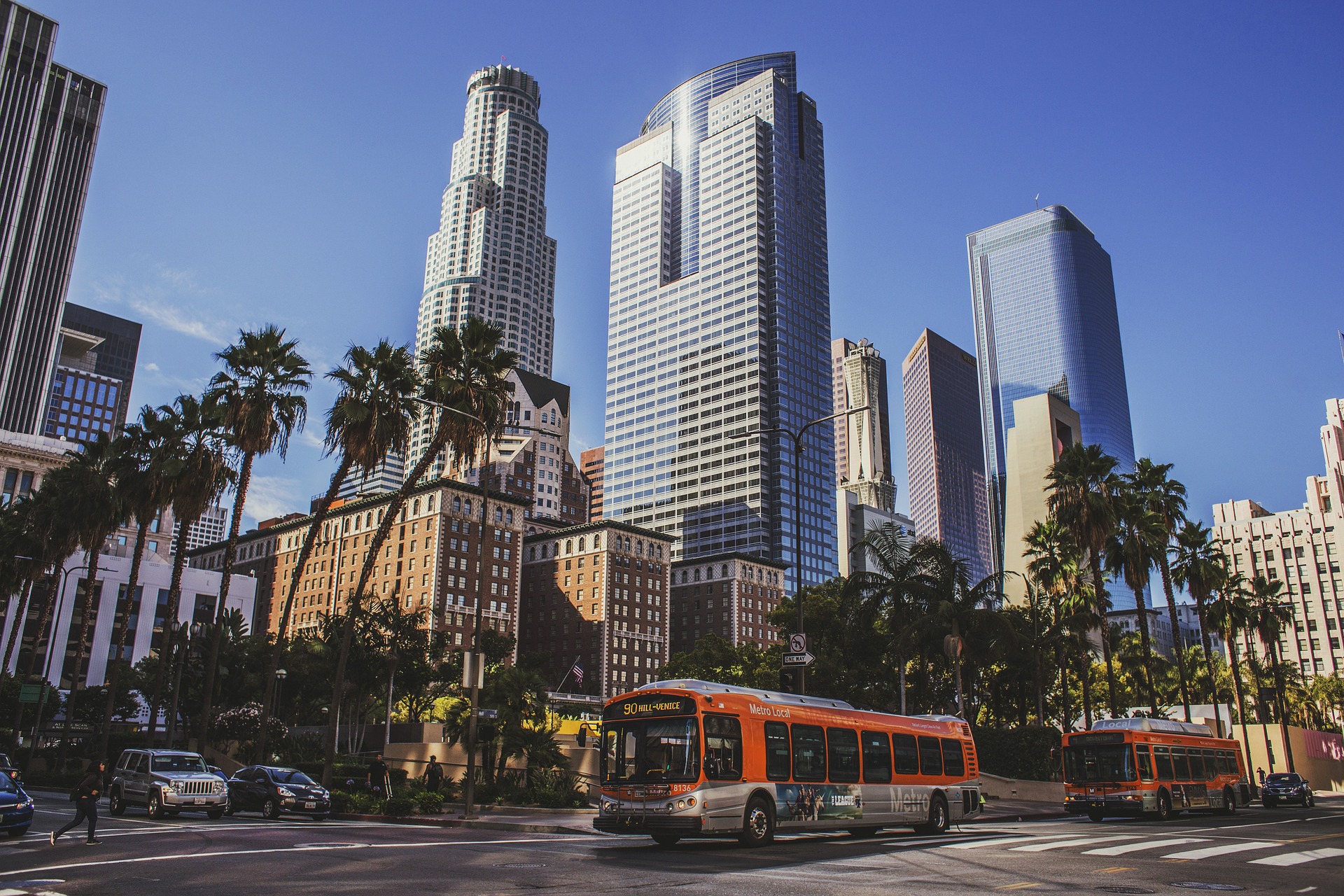Seven Transportation Experts Push for a Bolder and More Inclusive Transportation System
“Nobody walks in L.A.,” or so goes the1984 song by Missing Persons. That refrain is an exaggeration, of course, but L.A. is ranked below other cities in walkability and pedestrian-friendliness. Last year, the city earned a Walk Score of just 64— compared to San Francisco’s 84 and New York’s 88. As far as the quality of its public transit, Walk Scoreranked L.A. ninth in the nation, noting that in this city, “your best bet is to live close to work.”
Some Angelenos walk or bike to work, but most of us are getting where we need to go in via bus, train, or car. Every day,2,000 Metro buses crisscross L.A.’s streets, trains traverse 87 miles of light rail and subway tracks, and—well, then there’s the 405 at rush hour.
On the heels of new city plans to add bus and bike lanes, it’s a good time to take stock of the big picture in this big city. What should L.A. look like for pedestrians, bikers, drivers, and transit commuters? And what do we need to be thinking about as we look ahead? In advance of the Zócalo/Metro event “What is the Future of L.A.’s Transit?” we asked a variety of transit experts: What is missing from the current vision of L.A. transit future?
GLORIA OHLAND
Streets designed to move people, not cars

It wasn’t long ago when L.A.’s traffic problem called for a single solution: Build more roads. But the world has become so much more complex, crowded, and challenged—financially and environmentally—that today’s traffic solution must solve multiple problems and provide multiple benefits.
That requires a multi-modal system, with roads, bus, rail, car- and ride-sharing, scooters and skateboards, people on foot and on bikes—all working together seamlessly with the help of apps developed with local data. Urban real estate is expensive, better put to use for things other than wider roads or bigger parking lots. Moreover, the onus is on the transportation system to address the problems it begets by reducing greenhouse gas emissions, air pollution, and petroleum use.
This is why it’s imperative that drivers share the roads with pedestrians and cyclists. “Active transportation” is cheaper and greener than driving, provides connections to transit, and improves public health. People walking and biking on the street also create a sense of community and improve public safety—plus they patronize local businesses.
Streets designed for all users move people, not just cars. They can feature wide sidewalks, protected bike lanes, bus-only lanes, and real-time travel information provided at comfortable bus stops. They can be lined with trees whose canopies filter the air and mitigate the heat-island effect. If built with permeable pavement, they can filter and retain stormwater, and the use of “cool pavement” could lower temperatures in neighborhoods.
In this context, roads resume their historic role as shared public spaces at the center of local economies and community life. There can be locally owned shops, street furniture, and mixed-use and mixed-income housing so people can live near where they work and shop. Parking structures shared by residents and businesses can reduce housing construction costs.
This vision for the future of transportation in Los Angeles is richly interconnected with community life, and so green that it’s verdant.
RYAN SNYDER
Planning for flexible transit

The recently adopted Mobility Plan 2035 for the city of Los Angeles calls to improve the city’s buses with better signal-timing and pre-board fare payment. Regional planning efforts should follow Los Angeles’ lead and recognize that flexible and efficient transit can attract people out of their cars.
First, bus service on our city streets needs to be fast, efficient, and frequent. Buses running in dedicated lanes with transponders that trigger green traffic signals, like our Metro Rapid service, could offer a quick ride. Pre-board fare payment with wide doors could allow buses to operate like trains. Most important, L.A. buses need to run frequently to reduce wait times, especially with transfers.
We should also operate buses on our freeways, with stations every two to three miles and transfer points at freeway interchanges. The use of dedicated bus lanes or carpool lanes would allow for fast service. Ideally, buses would run every 10 minutes without getting stuck in traffic—a very attractive alternative to getting stuck in the freeway commute. The stations would need to be connected to Metro Rapid service, local buses, bicycle connections, and on-demand rides such as Uber and taxis.
Finally, instead of attempting to regulate these on-demand services out of the market, we should find rational ways to allow them to flourish, because they serve our scattered trip patterns better than fixed-route transit. As driverless cars become available, the economics of Uber Pool may even convince many of us to give up our cars altogether.
CARLA DE PAZ
A focus on low-income, transit-dependent communities

The county of Los Angeles has embarked on an effort to realize a more connected and “sustainable” city. This vision is anchored by numerous rail expansion projects, and focuses on encouraging commuters to favor public transportation over driving. But where do low-income transit riders—those who depend on our transit system the most—fit into the vision of L.A.’s transit future?
In Los Angeles, 75 percent of workers who commute via public transportation earn a household income of $25,000 or less a year. Yet research shows that transit investment often increases housing costs near transit corridors. In Boyle Heights, residents had high hopes for the Gold Line rail expansion and its promise of jobs and street improvements. Fast-forward 10 years, there are four new train stations in Boyle Heights, along with reduced bus service and increased real estate speculation. Now longtime community residents are struggling to live near the public transit they depend upon.
Advocacy efforts have pushed the Los Angeles County Metropolitan Transportation Agency (Metro) to adopt policy measures that will encourage the development of affordable housing on Metro-owned land. In Boyle Heights, where residents have fought for years to secure affordable housing near transit corridors, the effort feels like an afterthought. Now, as our region moves forward with the plan to transform many other neighborhoods in a similar way, we don’t have a comprehensive strategy that secures housing near transit for Metro’s core ridership.
Supporters of transit investment, public agencies, municipalities, affordable housing developers, and residents of neighborhoods impacted by transit expansion all need to sit down at the same table and create a strategy that puts low-income communities who depend on public transit at the forefront of any vision. Plans for L.A.’s transit future should not prioritize riders who don’t depend on transit over those who use the system out of necessity. To do so would simply continue a for-profit policymaking trend that favors short-term political gains over long-term sustainability in our city.
STEVE BOLAND
Courage to make tough choices

L.A.’s existing transit system is underappreciated. For $1.75 per ride—less than the $2.25-to-$2.50 fares in San Diego and San Francisco, or the $2 fares in Orange County—Metro connects people to jobs. DASH costs just 50 cents—35 cents if you use a TAP card. Yet these local buses and trains are bargains in part because activists were willing to be pushy.
On August 11, 2015, the L.A. City Council approved a Mobility Plan with hundreds of miles of protected bike and bus lanes. It was a strong statement, but it was just that—a statement of policy. Each individual project will have to be approved separately. Some will require removal of lanes of traffic, or parking. So far, at least, politicians generally haven’t shown the courage to make those kinds of tough choices.
It’s easy, if you think about it, to let voters decide whether to fund new rail lines and stations. The hard part is asking not for money, but for people to make real change and sacrifice.
If you build it, they won’t just come. More trains alone won’t lead to the transformative change L.A. is crying out for. Buses will need their own lanes, and it will have to become easier for cyclists and pedestrians to get to stops and stations. Because space is limited, this won’t be a win-win.
Ultimately, we will have to change not just the way we get around, but how we live. Our leaders will have to renew efforts to leverage that multi-billion-dollar investment in transit infrastructure to attract—and approve—transit- and pedestrian-oriented development. This will mean somewhat more density, and more traffic locally, if less regionally. There will be some near-term pain in pursuit of long-term gain.
SARAH CATZ
A plan for self-driving cars

There is little doubt that self-driving cars will be on our roads in the not-too-distant future. These vehicles have the potential to provide mobility options to not only the elderly, people with disabilities, and working parents, but to the general population. Automated vehicles might also solve what’s known as “the first and last mile problem” of getting to and from public transit stations. And if these vehicles turn out to be as safe as promised, there will be far fewer accidents on the road.
Planners, policy makers, stakeholders, and citizens all need to prepare for this game changer. We need to consider what regulations will be required, along with how automated vehicles could impact everything from our transit systems to greenhouse gas emissions. Will enough jobs be created in the autonomous vehicle industry to compensate for the jobs lost in the transit and transport industries? Will new highways, lanes, and parking lots be needed when connected vehicles are common sights on our streets and roads?
We need to stay at the forefront of determining what regulations are needed, unlike what has happened with decisions about ride-sharing services. While some regulations will fall to the federal government, car-cultured California—and especially Los Angeles—need to lead the charge. The technological explosion that allows us to share cars, houses, and numerous other things are causing so many conflicts with local governments and communities today. If our elected officials can create a road map to ease this particular technology into our daily lives and shape our long-range plans and goals for transportation and land-use planning, a welcome mat will be brought out for automated vehicles.
HASAN IKHRATA
An eye to the boomers and millennials

The future of transit in L.A. is full of great promise, with five Metro rail projects totaling $8 billion now under construction, and the city of L.A.’s new Mobility Plan 2035 prioritizing transit on key corridors. We’ve experienced record transit ridership levels not seen since the 1950s. Still, we can do better; less than 5 percent of all trips in the region are by transit.
The Southern California Association of Governments is developing its own plan to enhance our region’s mobility, sustainability, and economic vitality over the next 25 years. We call for a significant expansion of high-quality bus transit—recognizing that the vast majority (82 percent) of transit trips are by bus. We need a regional integration of smart fare-payment systems and real-time arrival information to make it easier for people to take transit. Ride-sourcing services like Uber and Lyft can help address the first/last mile challenge, or play a role when and where transit isn’t feasible.
We estimate that Southern California will grow by 4 million people by 2040. As we envision our future population’s needs, we should anticipate the housing and mobility preferences of the two largest demographic groups: retiring baby boomers and up-and-coming millennials. We need to intentionally align development with transit to better connect job centers and residential areas.
Lastly, we need a dedicated, sustainable revenue source to pay for transit. Hundreds of thousands of Southern Californians depend on transit every day, and this will grow with additional rail and bus service. Making sure we can pay for operations and maintenance is critical to success.
L.A. is on the right track for a bright transit future, provided we make strategic decisions that support transit as a meaningful choice for travelers.
RICHARD FRANCE
Accountability

Transit has a role to play in reducing greenhouse gas emissions, increasing the availability of affordable housing, and expanding access to well-paying jobs. Local transit investments can also be a powerful tool to promote more equitable access to our region’s economic, social, and natural resources.
But too often, we define the success of public transit investments in limited terms. Once new transit lines are running, we look at a host of ridership and operational statistics to measure efficiency and effectiveness. This data is important and useful, but we should also be discussing how to best quantify transit’s wider benefits.
Today, increasingly diverse coalitions, including Investing in Place andEnviroMetro, are pushing for local transit investments that yield more socially equitable, environmentally sustainable, and economically beneficial outcomes.
With foresight and coordination, transit investments can help connect low-income communities to job centers, healthcare, and educational opportunities. Strategic investments can spur the development of affordable housing, enhance efforts to implement green stormwater infrastructure, reduce the total number of miles we drive, and improve our health by encouraging walking and cycling.
But we won’t achieve those broader benefits unless we intentionally set out to accomplish them. Let’s create a systematic approach that sets long-term goals and assigns quantifiable metrics to achieve them. If we’re looking to transform our region by reimagining our transit network, then let’s make ourselves accountable for the outcomes that we want to see.





